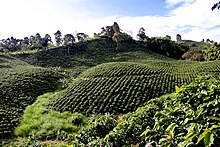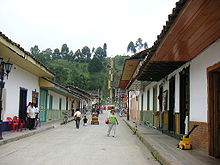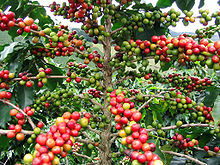Coffee growing region of Colombia
The coffee-growing region of Colombia (typical Spanish Eje Cafetero ("coffee axis"), also called Triángulo del Café ("coffee triangle") is located in the center of the Colombian part of the Andean region at an altitude of between 1200 m above sea level. NN and 2000 m above sea level NN , about 200 km west of Bogotá , almost exactly between Medellín and Cali . It is a huge, hilly, evergreen landscape criss-crossed by coffee plantations and is made up of three departments : Caldas , Risaralda and Quindío . Capital cities are Manizales , Pereira and Armenia .
Characteristic
Highland coffee from Colombia has become the epitome of quality worldwide. A rich, round aroma , good abundance and traces of slightly sweet nut aromas , these are the properties that characterize the high-quality, Colombian Arabica coffee . It is one of the few single- origin coffees that are sold and marketed internationally. Coffee from Colombia is divided into three categories, which are to be understood as a quality measure: Supremo, Excelso and Usual Good Quality (USG).
history
The first coffee plants came to Colombia in 1808 via a clergyman , who brought them by ship from the French Antilles and overland via Venezuela to Colombia and planted them. The fertile soil and the mild highland climate in equatorial regions ensured that the coffee production in Colombia has been a success story. Colombia has become famous worldwide for its highland coffee . With 12.98 million sacks (779,100 tons) in the 2016/2017 coffee year, the country was the third largest coffee exporter in the world, after Brazil and Vietnam. Colombia is the world's largest producer of Fairtrade coffee. The specialty is that the coffee can be harvested here twice a year. Here, too, mainly small farmers are responsible for the cultivation of almost exclusively Arabica beans. The total harvest in 2016 was around 810,000 tons. The first harvest period lasts from March to June and the second from September to December. Most of them are small farmers who almost only grow arabica beans in Colombia. Colombia's coffee industry employs around 730,000 people, most of them in the country's deprived rural areas.
geography
The coffee zone of Colombia is one of the most scenic regions in the country. Hundreds of mild coffee plantations can be found here . Colombia is the largest producer of Arabica beans in the world . Arabica is considered to be the finest bean and almost all top-quality coffees are made from pure Arabica. These impress with their overall very round aroma with traces of sweet nut aromas . The finest beans come from the highlands around the city of Medellín. The beans from there also fetch the highest prices when sold. The local conditions for growing the Arabica beans are also ideal , because they are in the high mountain regions. This region is dominated by lush vegetation, the extremely varied landscapes of the central cordillera of the Andes and a large number of coffee and banana plantations.
UNESCO World Heritage Site
The coffee triangle has been a UNESCO World Heritage Site since 2011 . According to UNESCO , this is the heart of Colombia, more precisely in the Valle del Cocora , where the wax palms, up to 60 meters high, are also located, the tallest palms in the world. The coffee triangle extends over six agricultural zones, 18 urban centers, 47 municipalities and four large cities.
UNESCO nomination text
“An exceptional example of a sustainable and productive cultural landscape that is unique and representative of a tradition and that is a strong symbol for coffee-growing areas worldwide - comprises six agricultural zones, including 18 urban centers on the foothills of the western and central mountain ranges of the Andes in the west belong to the country. It reflects a hundred-year-old tradition of coffee cultivation in the high forest, cultivated in small plots and how the farmers have adapted to the cultivation in difficult mountain conditions. The urban areas, which are mainly located on the relatively flat hills above sloping coffee fields, are characterized by the architecture of the Antioquin colonization with Spanish influence. Building materials were and will remain in some areas, straw clay and sugar cane for the walls and clay tiles for the roofs. "
Individual evidence
- ↑ Colombian Highland Coffee - History, Cultivation, Harvesting and Processing Reiseninkolumbien.com. Accessed May 9, 2019
- ↑ Colombia - the largest Arabica producer in the world baristaroyal.de accessed on February 29, 2020
- ^ History of coffee cultivation in Colombia . kaffeezentrale.de. Accessed May 5, 2017
- ↑ Coffee from Colombia - types, specialties, quality . Reise-nach-kolumbien.de. Retrieved April 12, 2017
- ↑ Export volume of the leading export countries of coffee worldwide from 2012 to 2017 (in 1,000 bags of 60 kilograms each ) , statista.de, accessed on April 21, 2019
- ↑ Brazil's top position in coffee production NZZ.ch. dated August 11, 2017
- ↑ The 10 largest coffee- growing countries tenoftheday.de, accessed on April 21, 2019
- ↑ The 10 largest coffee growing areas . coffeecircle.com. Retrieved April 12, 2017
- ↑ The desease that could change how we drink coffee bbc.co.uk from November 6, 2017 (English)
- ↑ World cultural heritage: Colombia's coffee triangle . Reise-nach-kolumbien.de. Retrieved April 11, 2017
- ↑ Nomination File . whc.unesco.org. Accessed April 11, 2017 (English)
- ^ Coffee Cultural Landscape of Colombia . whc.unesco.org. Accessed April 11, 2017 (English)
- ↑ World cultural heritage: Colombia's coffee triangle . Reise-nach-kolumbien.de. Retrieved April 11, 2017
- ↑ Valle del Cocora - hiking adventure with gigantic wax palms, mountains, cloud forest & hummingbirds passengeronearth.com. Retrieved May 9, 2019
- ↑ Colombia's Coffe area declared UNESCO World Heritage Landscape . procolombia.co. Retrieved April 11, 2017
- ^ Coffee Cultural Landscape of Colombia . whc.unesco.org. Retrieved April 11, 2017
Web links
- Website 'Cafe de Colombia' of the Federación Nacional de Cafeteros de Colombia (Spanish)
- Follow your nose into the coffee triangle
- Paisaje Cultural cafetero (Spanish)
Coordinates: 4 ° 42 ′ N , 75 ° 36 ′ W




